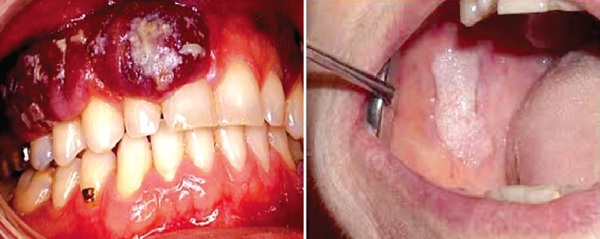
Oral cancer: a condition to watch out for
Generally, cancer is a disease that emanates from uncontrollable or malignant cell divisions that spread to surrounding tissues.
Advertisement
Suffice it to say that cancer is caused by changes to deoxyribonucleic acid (DNA).
Oral cancer is one of the numerous cancers that affect people globally and it is the focus of this piece for the purpose of public education.
Oral Cancer
Empirical studies and clinical data often reveal that oral cancer is the most common form of head and neck cancers.
Oral or mouth cancer thus develops in different parts of the oral cavity including the lips, gums, tongue, inner lining of cheeks, roof of mouth, floor of mouth (under the tongue) among others.
Simply put, oral cancer affects the mouth and the oropharynx.
The oropharynx includes parts of the tongue, the roof of the mouth and the middle part of the throat that is visible when the mouth is wide open.
Cancer in the oropharynx is, therefore, called oropharyngeal cancer or CA of the oropharynx.
Susceptibility
It is also trite empirical knowledge that about 11 people in 100,000 will develop oral cancer during their lifetime.
Regarding gender, men are found to be more susceptible to oral cancer than women but racially, whites are more likely to develop oral cancer than blacks.
Age wise, oral cancer typically affects people who are 60 years and above.
Mostly, oral cancer starts within the squamous cells of the oral cavity.
According to scientists, squamous cells look flat like fish scales under microscope.
When normal squamous cells become cancerous, their DNA changes and cells begin to multiply.
As time grinds, these cancerous cells can spread to other areas inside the mouth and other parts of the head and neck or other areas of the body.
Some specific lifestyles and other factors can increase one’s risk of developing oral cancer.
The predisposing factors for oral cancer thus include but not limited to any form of tobacco use, heavy alcohol use, excessive sun exposure to the lips, a sexually transmitted virus called human papillomavirus (HPV), and a weakened immune system.
In fact, about 75 per cent of tobacco users (smokers, chewers, snuffers etc.) tend to develop oral cancer.
However, clinical studies also found that about 25 per cent of oral cancer patients are people who do not smoke or have other known risk factors.
Symptoms
Unfortunately, oral cancer has several signs and symptoms that may be mistaken for common problems or changes in the mouth.
Signs and symptoms of mouth cancer may include lip or chronic mouth sore, a white or reddish patch inside the mouth, unintentional weight loss, chronic bad breath, loose teeth, mouth bleeding without any known cause, a growth or lump in the mouth, mouth pain, ear pain (earache) and painful swallowing.
Mostly, all these conditions appear as patches in the mouth and throat but with different colours.
They may be leucoplakia (white or grey patches) and erythroplakia (slightly raised or flat red patches).
Diagnosis
The individual may identify the oral cancer signs during self-examination.
Dentists may also spot potential oral cancer during a patient’s dental check-up.
This is one of the reasons why regular dental check-ups are highly advised and encouraged.
Detection of potential oral cancer may be followed up with preliminary tests or further examination by a maxillofacial surgeon, or ear, nose, and throat (ENT) specialists.
Various tests relevant to establishing the presence of oral cancer may include physical examination, brush (spatula or scrape) biopsy, incisional biopsy, direct and indirect laryngoscopy and pharyngoscopy (throat and voice box examination).
These examinations usually reveal the stages of the oral cancer.
Healthcare providers use staging information to recommend treatment and help predict chances of recovery.
Usually, clinicians determine oral cancer stages using the TNM approach, where T stands for primary tumour size and location, N for whether tumour has spread to other lymph nodes or not and M indicates if the tumour has metastasized or spread to other areas of the body.
Regarding the T, the tumour size is measured in centimetres as T1 (≤ 2cm), T2 (2 cm or < 4cm) and T3 (> 4cm). As such, early detection is paramount to providing cure and to establishing if the cancer has moved to other body parts.
Prevention and Treatment
It is trite assertion that prevention is better and cheaper than cure hence any form of disease and for that matter oral cancer must be prevented.
Much as there is no proven way to entirely prevent oral cancer, its risk may be reduced through stoppage or avoidance of the identified predisposing factors.
These must be accompanied with regular dental or oral check-ups.
Getting vaccinated for human papillomavirus, eating balanced diets among others can also help prevent oral cancers.
Three main treatment options are available for oral cancer.
These include surgery including glossectomy (partial or total removal of the tongue), radiation therapy and chemotherapy.
Treatment type is usually based on oral cancer type, the level of spread to other areas, patient’s age and general health.
The various surgeries may be combined with other known treatment types such as radiation, chemo, targeted and immunotherapies.
Unfortunately, about 1/3 of people treated for oral cancer develop new cancers.
Conclusion
Oral cancer is a serious condition, but it is preventable, and its early detection leads to successful treatment.
Regular self-examination and six-monthly dental clinic attendance are relevant to early detection.
Self-medications and herbal treatment of oneself are not advised.
Because cancer is deadly, its diagnosis can be scary and cause psychological trauma so oral cancer prevention is key.
The writer is a Hospital Administrator
Email:[email protected]




